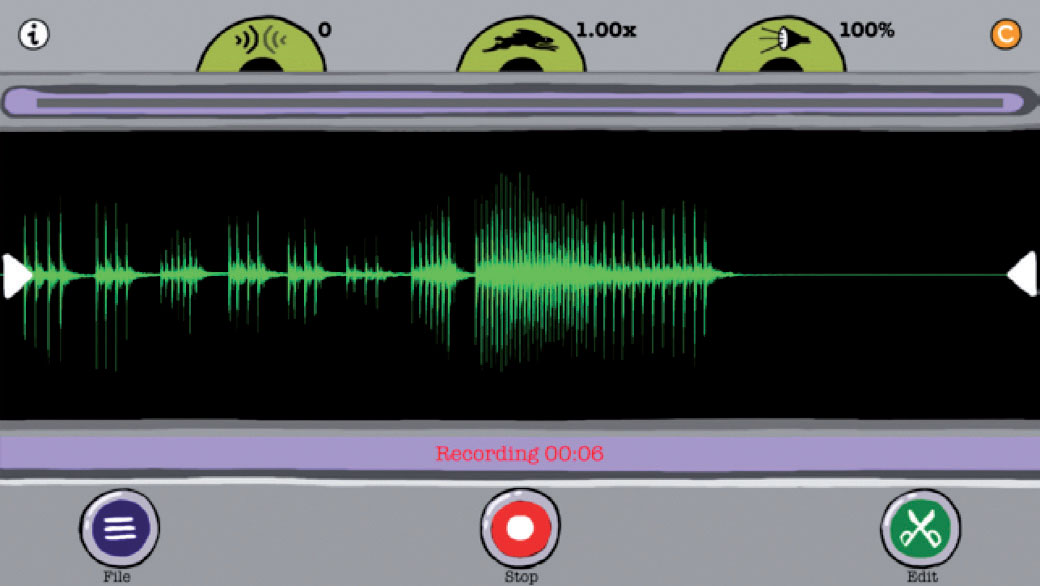
In my two previous articles, we have looked at internet browser applications that are quick, easy, and free to access. This month, we will be looking at a free iPad app called soundOscope that allows the user to easily record and edit sounds. Although the application contains a range of purchasable extra features, the free version of the app contains several key functions that make it a fun and useful classroom tool.
The lessons below can be delivered using only the free elements of the app. That said, I would encourage teachers to look at the in-app purchases not only because they are powerful audio editing tools, but also because every purchase helps to support the developers that have created such a useful application. soundOscope is fairly intuitive to use due to its simple design and clear functionality, which clearly demonstrate that the app has been made with young children in mind.
Over the past few months, a number of leading organisations – including Music Mark, the ISM, and the Music Education Council – have made references or recommendations about the importance of music education in Early Years, Foundation Stage (EYFS). A lot of this discussion is framed around the successor to the National Plan for Music Education, which is set to end in 2020 and which only covers music education between the ages of five and 18. With this in mind, I offer two simple lessons – one for EYFS and one for KS1 – that can be used by teachers. Feel free to follow it as written or to make adaptations using your professional judgments: what works in my classes might not work in yours, after all.
Please visit the Leicestershire Music Hub website to download the written planning for both of the aforementioned lessons, gain access to the PowerPoint slides, and see video tutorials and activities. The URL can be found at the end of this article. In each of the lesson plans, there is guidance on how a six-lesson unit of work can be delivered beginning with this material.
At the start of the plans, there are some punchy teacher tutorial videos that explain the key functions of the app and offer some support on how to record and export students’ work for assessment purposes. Either way, I hope it serves as inspiration for some fun and impactful lessons!
EYFS Lesson
Working in small, teacher-led groups, this lesson begins with a short video activity where students listen to a range of world sounds. The video contains clipart images of the sound sources to help support the learners visually. The students’ task is to listen to and identify which sound is the higher and lower pitch of the two played. After this warm-up activity, children are shown a variety of animals. Their task is to record their voices, instruments, or classroom objects to represent the animals displayed. Students can use the pitch wheel in the app to alter the recorded sound to make it sound more like the given animal – for example, a student might record a lion's roar sound with their voice and use the pitch wheel to make it sound lower and more like a real lion.
KS1 Lesson
Similar to the EYFS lesson, the children have a learning outcome that is based around technology and pitch. Students begin by using the same warm-up video, listening to world sounds, and discussing the concept of pitch through comparisons. This quickly moves on to activity videos where students compare pitches from different instruments and, eventually, pitches from the same instrument. Using their listening skills, the students play several rounds of listening games while discussing and evaluating the different pitches along the way. Students (and teachers!) are then shown a brief tutorial video of how to use the soundOscope app. The class is given time to explore the app, making their own discoveries before feeding these back to the class. Students are given time to record their own sounds, adjust the pitch as they wish and then to play them back to the class, two at a time. Discussions comparing the different pitches can than take place.
Conclusion
Generally speaking, interactive and creative forms of technology are commonplace in households up and down the country. Whether you like it or loathe it, most children will have an aptitude, curiosity, or, at the very least, an awareness of its existence. Suitable guidance, e-safety, and supervision of screen time should of course be provided. It is beneficial for young people to have an education in technology's artistic, creative, and problem-solving applications. By incorporating technology into music education, we can help young minds build upon the skills that they are picking up and using elsewhere.
All of the resources mentioned in this article are available for free online. The soundOscope app can be found by searching for it on the App Store.
leicestershiremusichub.org/prim-music-tech

A very simple, yet useful, recording interface
Does your hub have resources that you find engaging? We would love to hear how you make use of them in your lessons.
Get in touch with us: music.teacher@rhinegold.co.uk








